

|
ORDERS AND DECORATIONS OF POLAND Republic of Poland since 1990 (Click here to see updates) |
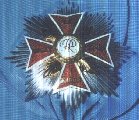
 1.Badge
1.Badge(Order Orla Bialego)
This order is believed to have been created by king Ladislas the Short in 1325, on the occassion of the wedding of his son, later king Casimir the Great. However it was officially instituted in 1705 by Augustus II (the Strong), King of Poland and Kurfürst of Saxony. It had initially the form of the oval red enameled medal, replaced by the cross in 1709 and worn from the neck, and from 1713 on the sash and with a star. Abolished 1793 after the third partition of Poland and renewed many times. The highest decoration of Poland before partitions, of the Grand Duchy of Warsaw (1807-1815) and Kingdom of Poland (1815-1831). After the defeat of the uprising of 1830 it was altered and included in the Russian award system, where it remained until the communist revolution of 1917. Revived in independent Poland by act of Parliament of February 4, 1921 as the highest award. Not conferred by the communist government after WWII (although never officially discontinued) was continued to be awarded by the President in Exile. Reestablished by Act of Parliament of October 16, 1992 as the uppermost Polish award. Conferred in a single class (GC) on both Polish citizens and foreigners, for exceptional merit to the Polish Country and Nation. President of Poland is always the Grand Master of the order.
Badge (since 1921): red enameled and white outlined gold Maltese cross with ball finials and gold rays between the arms. A white enameled crowned eagle with spread wings, heading left is superimposed on the cross. Reverse: white framed, granular, without enamel and bearing the motto: ZA : OJCZY : ZNE : I / NARÓD (for Country and Nation) on the arms. Central medallion: white, with entwined cipher RP (Rzeczpospolita Polska - Republic of Poland), surrounded by a green laurel wreath.
Star: eight sets of plain sliver rays. Superimposed is the cross, like the reverse of the badge, but without ball finials, the arms are red enameled and with gilt, shell-like flames between.
Sash: light blue, worn over the left shoulder In the Second Republic if a ribbon bar alone was worn,
it had a small rosette in the center.



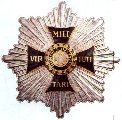 1.Star GC
1.Star GC(Order Virtuti Militari)


Instituted on June 22, 1792 by King Stanislas Augustus (Poniatowski) after the victorious battle of Zielence, during the Polish-Russian War. The original order had the form of the gold or silver oval medal, soon replaced by a black enameled cross. Suppressed 1793 after the partition of Poland, revived 1807 in five classes. Conferred also during the uprising of 1830 and suppressed again by the Russians after its defeat. The first decoration in independent Poland, renewed on August 1, 1919 (its official name Military Order Virtuti Militari was altered to War Order Virtuti Militari in 1933). It is the best known and most coveted of all Polish decorations, equivalent to British Victoria Cross or American Medal of Honor. It is conferred on soldiers of the Polish Armed Forces, irrespective of their rank, solely for deeds of exceptional bravery and valor at the risk of their lives before an armed enemy, above and beyond the call of duty. It can also be conferred on allied soldiers, civilians, military units, cities and other communities. The order has the following classes: GC, Commander, Knight, Gold Cross and Silver Cross. The four upper classes of the order are sparingly awarded. The GC could be awarded to a Commander-in-Chief for victory in war or decisive battle; Commander class - to an army commander for victoriously conducted war operations; Knight class - to a unit commander for distinguished commanding or war achievement; Gold Cross - any soldier awarded earlier with the Silver Cross. The Order Virtuti Militari, bestowed during World War II by the Polish Armed Forces (including resistance movement) was recognized and continued to award also by communist authorities. With the Act of October 16, 1992 on Polish Orders and Decorations it is the most senior decoration for war bravery.
Badge of the three upper classes: black enameled gold Leopold cross with ball finials and the motto on the arms: VIR (left), TUTI (right), MILI (upper), TARI (lower) (for military virtue). Medallion: gilt with a white crowned eagle with regalia, surrounded by a green laurel wreath. Cross reverse: gilt without enamel; the medallion bears the other motto - HONOR / I / OJCZYZNA (honor and country), and the year of institution, 1792. The two upper classes are surmounted by a gilt royal crown. Gold cross: slightly smaller than the knight cross, with gilt, black outlined arms and the motto in black; medallion as above. Silver cross: identical, with the arms silver instead of gilt.
Star GC: eight sets of plain sliver rays. Superimposed is the black cross without ball finials; between the medallion and wreath there is a black circle with the motto HONOR I OJCZYZNA in its upper part.
Badges in the People's Republic: as above, but the eagle had no crown; the crown surmounting the badge was substituted by an oval gold shield with the cipher RP (PRL - Polish People's Republic since 1952) surrounded by a gilt laurel wreath. The arms of the three upper classes are black enameled on reverse.
Ribbon: Garter blue with broad black side stripes (Grand Cross - 110 mm, Commander - 49 mm, other - 35 mm). In People's Poland - light blue with broad black stripes (Grand Cross - 115 mm, Commander - 50 mm, other - 40 mm).





Note: more on the Order Vitrtuti Militari (and
other military decorations) can be found at Polish
Militaria - the site of Col. Dr. Zdzislaw P. Wesolowski, dedicated
to Polish military awards and badges.
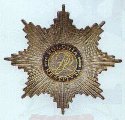
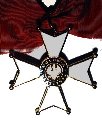 1.Commander [reverse]
1.Commander [reverse](Order Odrodzenia Polski)
Instituted by act of Parliament of February 4, 1921. Conferred on Polish and foreign citizens for merit to the Polish Country and Nation in the field of art and science, industry, agriculture, politics, philantrophy, as well as for the acts of civilian bravery and self-sacrifice. Until 1974, when the Order of Merit was established, it was also a "diplomatic" order awarded to foreign authorities on ceremonial occasions. The order was conferred in five classes: GC, Grand Commander, Commander, Officer (est. 1922) and Member.
Badge: white enameled gilt Maltese cross with ball finials. Medallion: white crowned eagle with regalia on red background; the blue circle bears the Latin motto: POLONIA RESTITVTA (Poland Restored). Reverse: gilt arms, without enamel; medallion bears the year 1918 on red background. The badges of Officer and Member are of a different size.
Star: eight sets of plain sliver rays. Medallion: entwined cipher RP (Rzeczpospolita Polska - Republic of Poland) and the order's motto in a blue circle around. The star of Grand Commander was worn on the right breast.
Badges in the People's Republic: as above; the eagle had no crown and regalia; the year 1918 on reverse replaced by 1944 (proclaiming Poland People's Republic). The star of Grand Commander was worn on the left breast.
Ribbon: red with narrow white side stripes
(Grand Cross - 100 mm, Commanders - 42-45 mm, other - 35-36 mm).
The class of Officer has a rosette on the ribbon.







 1.Grand Cross
1.Grand Cross(Order Krzyza Wojskowego)
Instituted on October 18, 2006. Awarded for outstanding military leadership or acts of valor during non-wartime operations and missions of the Polish Armed Forces outside the borders of the Polish Republic or counteracting terrorist attacks. The name refers to the Order Virtuti Militari, as it was called in the era of the Duchy of Warsaw (1807-15). The order is conferred in three classes: GC (neck decoration w. star), Commander and Knight. GC can be awarded to a unit commander for outstanding leadership or initiative combined with efficient commanding a military operation or action. Commander Cross - to a unit commander or another commissioned officer for meritorious leadership or deed, resulting in a successfully performed military operation or action, or to any officer, NCO or private who has been previously awarded the Knight Cross for an act of combat valor at a risk of life; in exceptional circumstances this class can be conferred to a staff officer for collaboration with the commander if the collaboration resulted in a success of the operation or action. Knight Cross - to any officer, NCO or private for an act of combat valor at a risk of life; this class can be conferred to a civilian or to a military unit. Soldiers of the unit awarded with the Knight Cross are authorized to wear a fourragere in the colors of the order's ribbon.
Badge: blue enameled massive Leopold cross without ball finials, with a silver Polish eagle superimposed on the center of the cross. The reverse is non-enameled, and bears the Latin motto of the order: "MILITO / PRO / PATRIA" (I fight for homeland), with the year of institution "MMVI" in Roman numerals and the number of award below. Placed along the vertical arms is also the coronation sword of Polish kings. The cross in all classes is surmounted by a crown, similar to the one surmounting the Polish eagle. Metal parts are gilt in the class of GC and silver in the remaining two classes.
GC Star: eight sets of plain sliver rays with the GC and crown superimposed on the center.
Fourragere: the cord of dark blue and crimson, with the ferret (pencil) finished in silver and adorned with an eagle. It is worn on the right shoulder while wearing the parade uniform and on the left shoulder on other types of uniform.
Note: it is the first fourragere in the Polish medallic history ever!
Ribbon: dark blue with wide crimson side stripes (Grand Cross and Commander - 45 mm, Knight - 40 mm).




 1.Cross 1st Class
[reverse]
1.Cross 1st Class
[reverse](Order Krzyza Niepodleglosci)
Instituted on August 5, 2010 by an act of Parliament, together with the Cross of Freedom and Solidarity . Awarded in two classes to individuals who between 1939 and 1956 contributed to the cause of Poland's independence and sovereignty through fight or work above and beyond their duty at a risk of life or freedom. Those who participated in or commanded an armed struggle are eligible for the 1st class of the order. The order refers in its form to the Independence Cross, established in 1930.
Badge 1st Class: blue enameled Greek cross 52 x 52 mm, with narrow arms and a gilt pin-stripe along the center. On the horizontal pin-stripes runs the motto: BOJOWNIKOM : NIEPODLEGLOSCI (to the fighters of Independence). On a square gilt shield in the center there is a stylized crowned eagle. The reverse is plain. The Cross is surmounted by a pair of crossed gilt swords on an ornamental rectangular frame. It is worn as a neck decoration
Badge 2nd Class: a similar cross, 40 x 40 mm, surmounted by an ornamental frame as in the 1st Class, albeit without the swords. It is worn on a ribbon on the left side of chest together with other decorations.
Note: the cross is almost identical to the Independence Cross of 1930, with the black enamel replaced by blue.
Ribbon: 45 mm wide in the 1st and 40 mm in the 2nd class, blue with gold-red-gold side stripes. If ribbon bars alone are worn, that of the first class has a rosette and gold lace in the center.




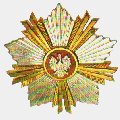 1.Star
1.Star(Order Zaslugi)
Order of Merit of the People's Republic of Poland (Order Zaslugi Polskiej Rzeczypospolitej Ludowej) was instituted by act of Parliament of April 10, 1974. Conferred to foreigners and Polish residents abroad for merit rendered to the Polish country. It was meant primarily as a diplomatic order and was conferred in five classes: GC, Grand Commander, Commander, Gold Decoration and Silver Decoration. In 1990 the name was altered to the Order of Merit of Republic of Poland (Order Zaslugi Rzeczypospolitej Polskiej), and the two lowest classes were renamed to Officer and Member respectively. The class of GC is awarded to heads of state and chefs of government.
Badge until 1990: red enameled cross of five arms with concave arm bases; arm edges are enameled white and form the letter V. Between the arms there are stylized rays, also in the form of the letter V. In the middle of the badge there is a silver eagle. The reverse is granular and has no enamel; the center bears the year 1974. The badge is surmounted by an oval device with letters "PRL" (the central R being bigger than the other two); two rays, like those between the arms extend from both sides. The three upper classes are attached to the ribbon through a trapezoid gilt device. All metal parts of the fifth class badge are silver; those of the other classes - gilt (except the eagle which is always silver).
Star: five sets of plain silver rays; between each pair there is a gilt ray like those between the arms of the badge but longer. The medallion bears an eagle on red background.
Badge and Star since 1990: the same as above; the eagle has a crown; the letters PRL are substituted by RP; since 1992 the year of institution has been removed from reverse of the badge. The star of Grand Commander is worn on the right breast.
Ribbon: originally light blue; since 1992 dark blue (Grand Cross - 100 mm, Commanders - 45 mm, other - 36 mm). Gold Decoration/Officer class has a rosette on the ribbon.




